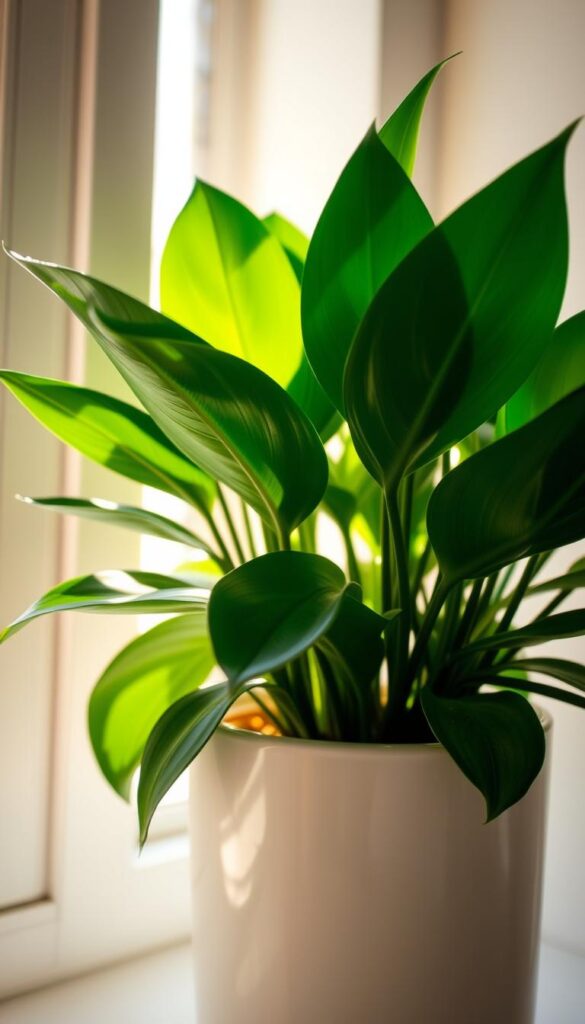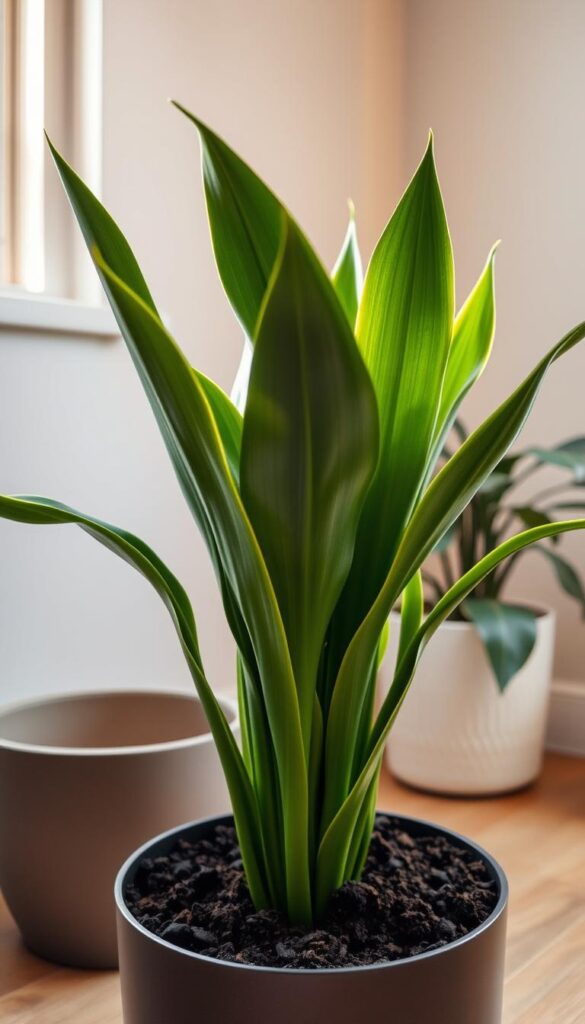Meet the ZZ Plant Raven, a stunning and low-maintenance houseplant that’s captured the hearts of many. With its unique, deep purple-black foliage that matures from bright lime green, this plant is a standout addition to any home. First discovered in 2015 and popularized by Costa Farms’ “Trending Tropicals” collection, the Raven has quickly become a favorite among plant enthusiasts.
What makes the ZZ Plant Raven so special? Not only does it thrive in low-light conditions, but it’s also incredibly drought-tolerant, making it perfect for busy individuals or those new to gardening. Plus, its glossy leaves add a touch of elegance to any room.
However, like any houseplant, the Raven has specific needs to stay healthy. Overwatering can lead to root rot, and it’s important to be aware of its toxicity to pets and humans. In this guide, I’ll walk you through everything you need to know to keep your ZZ Plant Raven happy and thriving. From light requirements to pest control, let’s dive into the essential care tips for this beautiful plant.
Understanding Your ZZ Plant Raven
Let me introduce you to the ZZ Plant Raven, a remarkable addition to any home. Known botanically as Zamioculcas zamiifolia ‘Raven’, this stunning houseplant belongs to the Araceae family and has quickly gained popularity since its debut in 2015.
Plant Profile and Background
First introduced by Costa Farms as part of their “Trending Tropicals” collection, the Raven has become a favorite among plant enthusiasts. Its deep, glossy foliage sets it apart, maturing from bright lime green to a striking purple-black color.
Unique Characteristics and Benefits
This tropical plant is perfect for those who appreciate low-maintenance beauty. It thrives in bright, indirect light but can adapt to low-light conditions, though its growth may slow. The Raven’s compact size, reaching about 3 feet tall, makes it ideal for indoor spaces.
| Characteristic | Ideal Condition | Tolerable Condition |
|---|---|---|
| Lighting | Bright, indirect light | Low light (may affect growth) |
| Water | Infrequent, well-draining soil | Drought-tolerant but not overwatering |
| Growth | Up to 3 feet tall | Slow growth in low light |
Owning a Raven plant offers numerous benefits, including its low water needs and adaptability to various lighting conditions, making it perfect for busy individuals or those new to gardening.
Step-by-Step ZZ Plant Raven Care Guide
Now that we’ve covered the basics, let’s dive into the nitty-gritty of keeping your ZZ Plant Raven thriving. I’ll share my personal tips and tricks to ensure your plant stays healthy and happy all year round.
Choosing the Ideal Environment
The first step in caring for your Raven plant is selecting the perfect spot. Bright, indirect light is ideal, but it can tolerate low-light conditions too. Avoid direct sunlight, as it can scorch the leaves. Keep your plant in an area with stable temperatures between 65°F and 75°F for optimal growth.
Planting Techniques and Pot Selection
When planting, choose a pot that’s slightly larger than the plant’s root system. Use a well-draining soil mix, adding perlite or sand to improve drainage. This helps prevent root rot, a common issue with overwatering. Water sparingly, allowing the soil to dry completely between waterings.
Fertilizing and Routine Maintenance
Feed your Raven plant with a balanced fertilizer during the growing season (spring and summer). Dilute the fertilizer to half the recommended strength to avoid burning the roots. Repotting is only needed every 2-3 years when the plant outgrows its container. Look for signs like roots emerging from drainage holes as a cue to repot.

Optimizing Light, Soil, and Water Conditions
To keep your Raven plant thriving, it’s essential to optimize its environment. By focusing on light, soil, and water conditions, you can create the perfect setup for your houseplant to flourish.
Best Practices for Bright Indirect Light
Bright indirect light is crucial for maintaining your Raven plant’s deep foliage color and overall health. To achieve this, place your plant near an east- or west-facing window. Avoid direct sunlight, especially during the harsh midday sun, as it can scorch the leaves. During summer, consider repositioning your plant to a spot with filtered sunlight to prevent leaf burn.
If you notice the leaves losing their vibrant color, it might be a sign that the lighting conditions aren’t optimal. Adjusting the plant’s position can help restore its health and appearance.
Creating a Well-Draining Soil Mix
A well-draining soil mix is vital to prevent root rot. You can create a custom mix by combining standard potting soil with perlite or pumice. This blend allows excess water to escape, ensuring the roots stay healthy. Avoid using dense or heavy soils, as they can trap water and lead to root issues.
Watering Tips to Prevent Overwatering
Watering is one of the most critical aspects of Raven plant care. Allow the soil to dry completely between waterings, especially during summer and winter. Overwatering can lead to root rot, so it’s better to err on the side of caution.
During the growing season (spring and summer), you may need to water more frequently, but always check the soil moisture first. In winter, reduce watering to once a month, as the plant grows more slowly.
| Factor | Optimal Condition | Considerations |
|---|---|---|
| Lighting | Bright, indirect light | Avoid direct sunlight; adjust position seasonally |
| Soil | Well-draining mix with perlite or pumice | Prevents waterlogging and root rot |
| Water | Infrequent, allowing soil to dry completely | Adjust frequency based on season |

By optimizing light, soil, and water conditions, you’ll create an ideal environment for your Raven plant to thrive. Remember to monitor your plant’s responses and adjust your care routine accordingly for the best results.
Preventing Common Issues, Pests, and Diseases
Keeping your Raven plant healthy involves being proactive about potential issues. Common problems include root rot, pests, and toxicity concerns. Let’s explore how to identify and address these challenges effectively.
Recognizing Signs of Root Rot and Overwatering
Root rot is a prevalent issue, often caused by overwatering. Early signs include yellowing leaves and mushy stems. If you notice these symptoms, stop watering immediately and inspect the roots. Soft, rotting roots indicate root rot. To save your plant, trim affected roots with sterile tools and repot it in fresh, well-draining soil.
Managing Pests and Toxicity Concerns
Regular inspections are key to catching pests like mealybugs, scale, spider mites, and thrips early. Use neem oil or insecticidal soap to treat infestations. Additionally, the Raven plant is toxic to pets and humans, so keep it out of reach of children and animals. Monthly checks can help prevent issues and ensure your plant remains healthy year-round.
- Inspect your plant monthly for pests or disease.
- Water sparingly, allowing soil to dry completely between waterings.
- Keep your Raven plant away from pets and children due to its toxicity.
By staying vigilant and following these tips, you can prevent common issues and keep your Raven plant thriving.
Final Thoughts for Thriving Raven ZZ Plants
As you continue your journey with the Raven plant, remember that its success lies in balance. Providing bright, indirect light and allowing the soil to dry between waterings will keep it thriving. Regular checks for pests and proper drainage will prevent common issues, ensuring your plant stays healthy.
Over time, you’ll find that small adjustments make a big difference. Whether it’s repositioning for better light or repotting as it grows, each step is a chance to learn and connect with your plant. It’s a journey of growth, not just for the Raven, but for you as a gardener.
With its striking foliage, the Raven plant adds a touch of tropical elegance to any room. By staying mindful of its needs, you’ll enjoy the beauty it brings to your home. Happy growing—your Raven plant is sure to flourish with the care you provide!
